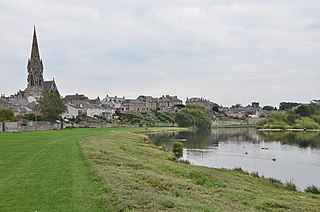Related Research Articles

Hawick is a town in the Scottish Borders council area and historic county of Roxburghshire in the east Southern Uplands of Scotland. It is 10 miles (16.1 km) south-west of Jedburgh and 8.9 miles (14.3 km) south-south-east of Selkirk. It is one of the furthest towns from the sea in Scotland, in the heart of Teviotdale, and is the biggest town in Roxburghshire. The town is at the confluence of the Slitrig Water with the River Teviot.

Paisley is a large town situated in the west central Lowlands of Scotland. Located north of the Gleniffer Braes, the town borders the city of Glasgow to the east, and straddles the banks of the White Cart Water, a tributary of the River Clyde.

Peebles is a town in the Scottish Borders, Scotland. It was historically a royal burgh and the county town of Peeblesshire. According to the 2011 census, the population was 8,376 and the estimated population in June 2018 was 9,000.

Selkirk is a town and historic royal burgh in the Scottish Borders council district of southeastern Scotland. It lies on the Ettrick Water, a tributary of the River Tweed.

Galashiels is a town in the Scottish Borders with a population of around 12,600. Its name is often colloquially shortened to "Gala". The town is a major commercial centre for the Borders region with extensive history in the textile industry. Galashiels is the location of Heriot-Watt University's School of Textiles and Design.

Bishopton (/bɪʃəptən/) is a village in Renfrewshire, Scotland. It is located around 2 miles (3 km) west of Erskine.
Almonte is a former mill town in Lanark County, in the eastern portion of Ontario, Canada. Formerly a separate municipality, Almonte is a ward of the town of Mississippi Mills, which was created on January 1, 1998, by the merging of Almonte with Ramsay and Pakenham townships. Almonte is 46 kilometres (29 mi) south-west of downtown Ottawa. Its population as recorded in the 2016 Canadian Census was 5,039.

Tillicoultry is a town in Clackmannanshire, Scotland. Tillicoultry is usually referred to as Tilly by the locals.

Bruce Peebles & Co. Ltd. was an Edinburgh industrial electrical engineering company.

Kelso is a market town in the Scottish Borders area of Scotland. Within the boundaries of the historic county of Roxburghshire, it lies where the rivers Tweed and Teviot have their confluence. The town has a population of 5,639 according to the 2011 census and based on the 2010 definition of the locality.

Menstrie is a village in the county of Clackmannanshire in Scotland. It is about five miles east-northeast of Stirling and is one of a string of towns that, because of their location at the foothill base of the Ochil Hills, are collectively referred to as the Hillfoots Villages or simply The Hillfoots.

Granton is a district in the north of Edinburgh, Scotland. Granton forms part of Edinburgh's waterfront along the Firth of Forth and is, historically, an industrial area having a large harbour. Granton is part of Edinburgh's large scale waterfront regeneration programme.

Walkerburn is a small village in the Scottish Borders area of Scotland, on the A72 about 8 miles (13 km) from Peebles and 10 miles (16 km) from Galashiels.
Courtaulds was a United Kingdom-based manufacturer of fabric, clothing, artificial fibres, and chemicals. It was established in 1794 and became the world's leading man-made fibre production company before being broken up in 1990 into Courtaulds plc and Courtaulds Textiles Ltd.

Fountainbridge is an area of Edinburgh, Scotland, a short distance west of the city centre, adjoining Tollcross with East Fountainbridge and West Port to the east, Polwarth to the west and south, Dalry and Haymarket to the north and Gorgie and North Merchiston to the west. The main streets through the area are Fountainbridge and Dundee Street.

Rosewell is a former mining village in Midlothian, Scotland, east of Roslin and south-west of Bonnyrigg. The village is in the civil parish of Lasswade and was previously a separate ecclesiastical parish, but has its own Community Council, namely Rosewell and District.

Flinders Lane is a minor street and thoroughfare in the Melbourne central business district of Victoria, Australia. The laneway runs east–west from Spring Street to Spencer Street in-between Flinders and Collins streets. Originally laid out as part of the Hoddle Grid in 1837, the laneway was once the centre of Melbourne's rag trade and is still home to boutique designers and high-end retailers including Chanel, now perched alongside numerous upscale hotels like the W Hotel Melbourne and Adelphi Hotel, loft apartments, cafes and bars.
Events from the year 1965 in Scotland.

The Kirna, known locally as Kirna House, is a Category A listed villa in Walkerburn, Peeblesshire, Scotland. It is one of four villas in Walkerburn designed by Frederick Thomas Pilkington between 1867 and 1869 for the Ballantyne family. It is listed as a fine example of a Pilkington mansion retaining original external features, a fine interior, and for its importance as a Ballantyne property.
References
- 1 2 Hounslea, Tessa (7 September 2015). "Moorbrook Textiles finds buyers for Robert Noble and Replin Fabrics". Drapers. Retrieved 26 December 2018.
- ↑ "George Roberts and Co., Woollen Manufacturer, Selkirk". Archives Hub. Retrieved 31 January 2021.
- ↑ "Robert Noble: Timeline". Robert Noble. Retrieved 31 January 2021.
- ↑ "Job losses as Robert Noble mill in Peebles to close". www.bbc.co.uk. Retrieved 31 January 2021.
- ↑ "Blackpool: From the courts 27-06-17". www.scotsman.com.
- ↑ "Scottish Government planners reject bid to build 69 houses on old Peebles mill site". The Southern Reporter. Retrieved 31 January 2021.
- ↑ "Project: March Street Mills Redevelopment". Peebles Community Trust. Retrieved 31 January 2021.